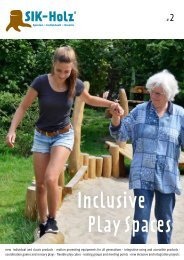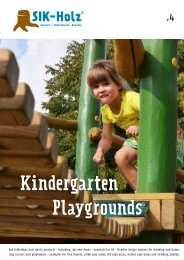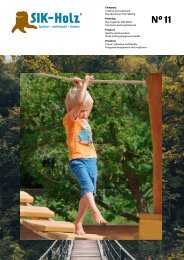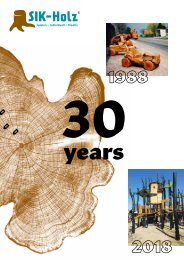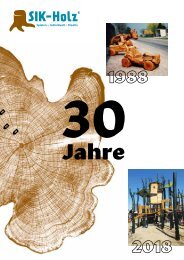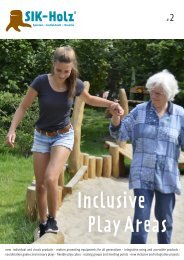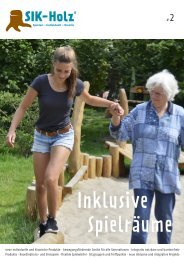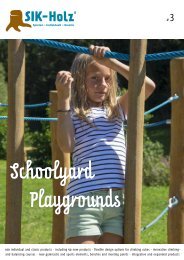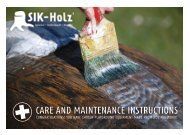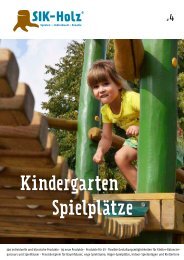SIK-Holz_Schulhof_2016_en
- No tags were found...
Create successful ePaper yourself
Turn your PDF publications into a flip-book with our unique Google optimized e-Paper software.
Nature Area ‹ <strong>SIK</strong>-<strong>Holz</strong>®<br />
09<br />
The child's interest<br />
dep<strong>en</strong>ds on the<br />
possibility of making<br />
his own discoveries.<br />
m. montessori<br />
Natural Area<br />
Experi<strong>en</strong>ce and understand nature<br />
With relatively small financial means, dreary schoolyards<br />
can be turned into op<strong>en</strong> air laboratories for<br />
a dynamic and <strong>en</strong>thusiastic learning experi<strong>en</strong>ce. To<br />
achieve this, every schoolyard needs a sustainable<br />
"gre<strong>en</strong> framework" of trees, shrubs, lawns and flower<br />
beds. The more diversity, the better. It is comparatively<br />
easy to bring a beautiful flower field to the schoolyard.<br />
It requires only a pieces of op<strong>en</strong> soil. Already in the<br />
first year many wild herbs will grow.<br />
The interaction of flora and fauna can be increased<br />
within the areas of the schoolyard which are not<br />
frequ<strong>en</strong>ted very much. By creating heaps of leaves and<br />
stones, and ideally also a small pond, many birds, insects<br />
and small animals will be attracted to the schoolyard.<br />
Nesting boxes and insect hotels can be built to<br />
observe those animals. Each child should also be able<br />
to experi<strong>en</strong>ce the life of a plant from sowing to harvest<br />
during his school days. No great efforts are necessary<br />
for this. A small bed for each child, about half a<br />
square meter, is suffici<strong>en</strong>t. Raised beds with a height<br />
of 50 cm are especially advantageous. Here, childr<strong>en</strong><br />
who use wheelchairs or carry prostheses can also do<br />
gard<strong>en</strong> work. Another way to create a little gard<strong>en</strong> for<br />
each child is to use mobile vegetable boxes that can be<br />
tak<strong>en</strong> home during the holidays. After the harvest, the<br />
vegetables can be prepared and eat<strong>en</strong> together. Or it is<br />
processed into jam, dried fruit or tea. All of these are<br />
defining social experi<strong>en</strong>ces with very complex learning<br />
cont<strong>en</strong>ts. In the computer age these things must not<br />
be lost.<br />
Each child should also learn how waste food and plant<br />
matter become valuable compost. Here the importance<br />
of earthworms, snails, beetles and other bugs can be<br />
learned through observation. Simple compost containers<br />
can be constructed by stacking and wedging some<br />
wood<strong>en</strong> boards. By ev<strong>en</strong>ly mixing dry and wet waste,<br />
annoying odors are prev<strong>en</strong>ted. But these also belong to<br />
the s<strong>en</strong>sual experi<strong>en</strong>ce of nature in a schoolyard.<br />
Other s<strong>en</strong>sory experi<strong>en</strong>ces in the schoolyard can be<br />
self-built wind chimes that hang in the trees and<br />
appeal to the s<strong>en</strong>se of hearing. Or the familiar touch<br />
path, which, by touching natural elem<strong>en</strong>ts with feet<br />
or hands, trains the tactile s<strong>en</strong>se and the temperature<br />
s<strong>en</strong>se. The s<strong>en</strong>se of balance is trained by interesting<br />
opportunities for movem<strong>en</strong>t. There are many examples<br />
for this on the following pages. Only the <strong>en</strong>tirety of<br />
the s<strong>en</strong>ses lets us experi<strong>en</strong>ce the dim<strong>en</strong>sions of our self.




